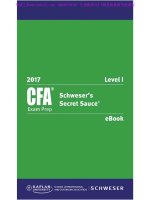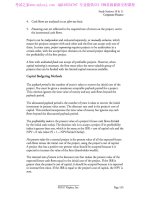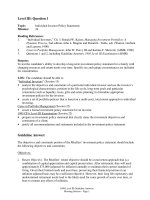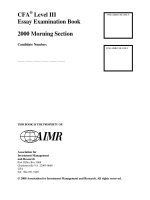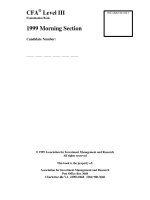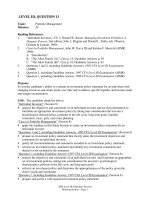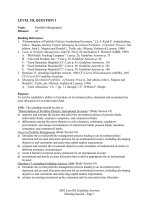2017 mock exam CFA level 1 wiley
Bạn đang xem bản rút gọn của tài liệu. Xem và tải ngay bản đầy đủ của tài liệu tại đây (1.45 MB, 110 trang )
2017
CFA® EXAM REVIEW
ANSWERS
AND
SOLUTIONS
LEVEL I CFA
®
MOCK EXAM 1
Mock Exam
1
Mock Exam 1 – Morning Session – Solutions
Questions 1–18 relate to Ethics
1. Phil Jones, CFA, has just finished researching Alpha One Inc. and is about to issue an unfavorable
report on the company. His manager does not want him to state any adverse opinions about Alpha
One, as it could adversely affect their firm’s relations with the company, which is an important
investment banking client. Which of the following actions by the manager most likely violates
Standard I (B): Independence and Objectivity?
A. Putting Alpha One on a restricted list
B. Asking Jones to issue a favorable report
C. Asking Jones to only state facts about the company
Answer: B
According to Standard I (B), if a firm is unwilling to allow dissemination of adverse opinions
about a corporate client, it may put the company on a restricted list. This would ensure that the
firm only disseminates factual information about the company.
2. Which of the following is least likely a violation of Standard I (D): Misconduct?
A. Engaging in frequent fights on the trading floor
B. Offering higher-quality services to certain clients
C. Getting intoxicated during office hours
Answer: B
Offering premium levels of service to certain clients (without disclosing these premium services
and making them available to all clients) is a violation of Standard III (B): Fair Dealing, but not
Standard I (D): Misconduct.
3. Martha Stevens, CFA, is an investment manager who uses her friend, Robert James, exclusively
for her clients’ brokerage transactions. James provides better services than other brokers in return
for a slightly higher price, which Stevens believes is justified. Which of the following statements
is most accurate?
A. Stevens is in violation of Standard III (A): Loyalty, Prudence and Care.
B. Stevens is in violation of Standard III (B): Fair Dealing.
C. Stevens has not violated any standard.
Answer: C
Stevens is justified in using James as a broker, as the slightly higher charges are justified by the
better service.
© Wiley 2017 All Rights Reserved. Any unauthorized copying or distribution will constitute an infringement of copyright.
72
4. Alexis King, CFA, an investment manager at Invest One Corporation, is asked by her supervisor
to make a presentation to a potential client. In the presentation, King uses weighted composites
of all similar portfolios to present the firm’s performance over the past 10 years, during which the
firm earned an average return of 13%. Which of the following statements is most accurate?
A. King has violated Standard III (D): Performance Presentation.
B. King has violated Standard I (C): Misrepresentation.
C. King has not violated any standards.
Answer: C
King has not violated any standard, as she has not made any false statements or guarantees.
Further, she used weighted composites of similar portfolios rather than a single representative
account to represent the firm’s performance over the period.
5. Frank Henry, CFA, works as an investment manager at Beta Financials. One of his clients offered
him a free trip to Mauritius for excellent performance, which Henry accepted. Henry’s boss
recently learned about this arrangement from another employee, but did not do anything about the
arrangement, as the client was very important to the firm. Which of the following is most likely?
A. Henry violated Standard IV (B): Additional Compensation Arrangements.
B. Henry’s boss violated Standard IV (C): Responsibilities of Supervisors.
C. Henry violated Standard IV (B): Additional Compensation Arrangements and his boss
violated Standard IV (C): Responsibilities of Supervisors.
Answer: C
• Henry violated Standard IV (B) by not obtaining written consent from his employer
before accepting the gift.
• Henry’s boss violated Standard IV (C) by failing to take appropriate action.
© Wiley 2017 All Rights Reserved. Any unauthorized copying or distribution will constitute an infringement of copyright.
73
6. Which of the following is least likely a violation of Standard V (B): Communication with Clients
and Prospective Clients?
A. An analyst recommends an investment to a client without going into specific details because
she feels that the client would not be able to understand the complex models involved.
B. An analyst divulges confidential information about current clients to prospective clients.
C. An analyst states his strong beliefs as facts in a research report.
Answer: B
• Divulging confidential information about a client to prospective clients is a violation of
Standard III (E): Preservation of Confidentiality.
• The other two statements describe violations of Standard V (B).
7. Which of the following is most likely a violation of Standard III (B): Fair Dealing?
A. An analyst emphasizes the high returns of a trading strategy to a client without providing
detailed information about the strategy.
B. An analyst carries out trades for discretionary accounts before non‐discretionary accounts.
C. An analyst guarantees high returns on a risky investment.
Answer: B
• Discriminating against certain clients when carrying out trades is a violation of Standard
III (B): Fair Dealing.
• Statement A describes a violation of Standard V (B): Communication with Clients and
Prospective Clients.
• Statement C describes a violation of Standard I (C): Misrepresentation.
8. Laura Bolt, CFA, resides in a country called Lavasia, but frequently does business in Magmaland,
with a client who is a citizen of Magmaland. Lavasia’s law applies in this case and states that
laws of the client’s home country govern. Lavasia’s laws are more strict than the Code and
Standards, while Magmaland’s laws are less strict than the Code and Standards. Bolt is most
likely required to adhere to:
A. The laws of Lavasia.
B. The Code and Standards.
C. The laws of Magmaland.
Answer: B
Because applicable law (Lavasia’s law) states that the law of the client’s home country governs
(which is less strict than the Code and Standards) Bolt must adhere to the Code and Standards.
© Wiley 2017 All Rights Reserved. Any unauthorized copying or distribution will constitute an infringement of copyright.
74
9. An analyst is flown along with a group of peers to a company’s mining facilities on a chartered
flight, and put up in a hotel for three days. In determining whether these arrangements violate
Standard I (B): Independence and Objectivity, the analyst must consider:
A. Whether she can remain objective and whether her integrity might be perceived by her
clients to have been compromised.
B. Whether she can remain objective and whether her employer is confident that she will remain
objective.
C. Only whether her integrity might be perceived by her clients to have been compromised.
Answer: A
In the final analysis, analysts must consider both, whether they remain objective and whether
their integrity might be perceived by clients to have been compromised in evaluating whether
such arrangements are acceptable.
10. Laura Jameson, CFA, is a portfolio manager at ALT Investments. Her firm is allocated a very
significant number of shares in the IPO of Hotstock Ltd., a company that Jameson is very bullish
on. Excited by the prospect of earning an excellent return for her clients, Jameson allocates the
shares evenly across all accounts under management including those of her relatives. Jameson
most likely:
A. Violated Standard III (C): Suitability.
B. Violated Standard III (A): Loyalty, Prudence and Care.
C. Has not violated the Code and the Standards.
Answer: A
Jameson violated Standard III (C) because she did not evaluate the suitability of the investment
for each account under her management. Each investor has unique return objectives and risktolerance levels.
11. To comply with Standard III (E): Preservation of Confidentiality, members must preserve the
confidentiality of information communicated to them by:
A. Past, current, and prospective clients.
B. Past and current clients only.
C. Current and prospective clients only.
© Wiley 2017 All Rights Reserved. Any unauthorized copying or distribution will constitute an infringement of copyright.
75
Answer: A
Standard III (E) requires that members maintain the confidentiality of all information passed on
to them by past, current, and prospective clients.
12. Abeer Dagha, CFA, has just been hired by Superior Investments after spending 20 years with
Quality Investments. When Dagha begins her work with Superior Investments she wants to get
in touch with her former clients because she knows them well and she is confident that they will
follow her to her new firm. Dagha would most likely:
A. Be in violation of Standard IV (A): Loyalty if she has not signed a non‐compete agreement
with Quality Investments and decides to contact her former clients.
B. Be in violation of Standard IV (A): Loyalty if she uses client lists, which she took from
Quality Investments with permission, to get in touch with her former clients.
C. Not be in violation of Standard IV (A): Loyalty if she has not signed a non‐compete
agreement with Quality Investments, and uses contact information that she has retained in
her memory.
Answer: C
• Standard IV (A) does not classify knowledge of names and existence of former clients as
confidential information. This information can be used to benefit a new employer just as
the skills and experience acquired at the previous employer can be used to now benefit
the new employer.
• Members can contact clients of their previous firm, absent a non‐compete agreement.
13. Which of the following is least likely to violate Standard VII (B): Reference to CFA Institute, the
CFA Designation and the CFA Program?
A. A Level III candidate referring to herself as CFA, Level II.
B. A Level III candidate awaiting results referring to himself as CFA, expected 2009.
C. An investment manager stating, “Completion of the CFA program has enhanced my portfolio
management skills.”
Answer: C
The other two choices are violations of Standard VII (B).
© Wiley 2017 All Rights Reserved. Any unauthorized copying or distribution will constitute an infringement of copyright.
76
14. According to the CFA Institute Standards of Professional Conduct, which of the following must
least likely be disclosed to clients?
A. Referral fees
B. Disclosures of personal holdings
C. Additional compensation earned by the member from tutoring candidates for the CFA exams
in her spare time
Answer: C
• According to Standard VI (A): Disclosure of Conflicts, members and candidates must
make full and fair disclosure of all matters that could reasonably be expected to impair
their independence and objectivity or interfere with their respective duties to their clients,
prospective clients, and their employer.
• The scenario states that the member tutors CFA candidates during her spare time, which
is unlikely to interfere with her duties to her clients. She should, however, keep her
employer informed.
15. Which of the following is least likely a reason for the creation of GIPS Standards?
A. To remove the effects of survivorship bias
B. To prevent firms from presenting the performance of all portfolios under management
C. To ensure that performance is presented consistently over a period of time
Answer: B
The GIPS Standards were created to prevent firms using only their top‐performing portfolios to
represent their overall performance.
16. Which of the following is least likely a characteristic of GIPS?
A. The investment management firm must define the entity that claims compliance.
B. All fee‐paying discretionary portfolios are required to be included in composites defined
according to a similar strategy or investment objective.
C. After presenting five years of compliant history, a firm must add annual performance each
year going forward up to a maximum of 10 years.
Answer: C
A firm is initially required to present at least five years of compliant history and must add annual
performance each year going forward up to 10 years at a minimum.
© Wiley 2017 All Rights Reserved. Any unauthorized copying or distribution will constitute an infringement of copyright.
77
17. Gregory Robinson, CFA, works as a research analyst at a brokerage firm. His wife, Laura
Robinson, CFA, is an analyst at another firm. One morning, Robinson elects to stay at home by
the side of his ill wife. He receives a call from James, an investment banker, who informs him
that the two largest mining companies that Robinson covers are getting taken over at a 50%
premium to their current market values. This information has not been released to the public yet.
Laura overhears the entire conversation and immediately purchases the stock for her clients.
Standard II (A): Material Non‐Public Information has most likely been violated by:
A. Mr. Robinson and James.
B. Mr. and Mrs. Robinson.
C. All three of them.
Answer: C
• All three parties have violated Standard II (A).
• Mr. Robinson violated the standard because he failed to prevent the transfer and misuse
of material, non‐public information.
• James had a duty to keep this non‐public material information to himself.
• By trading on material non‐public information, Mrs. Robinson has also violated the
Standard.
18. To avoid plagiarism an analyst should most likely disclose:
A. The sources of widely available public information.
B. The sources of summarized reports of other analysts.
C. The sources of both widely available public information and summarized reports of other
analysts.
Answer: C
According to Standard I (C): Misrepresentation, an analyst must disclose the source of the
information even if it is widely available to the public. Disclosure must also be made if the
analyst is using summarized versions of reports prepared by someone else.
© Wiley 2017 All Rights Reserved. Any unauthorized copying or distribution will constitute an infringement of copyright.
78
Questions 19–32 relate to Quantitative Methods
19. An analyst rates individual stocks in the market index as under perform, neutral, or outperform.
The type of scale that is used to measure this data is most likely a(n):
A. Ordinal scale.
B. Ratio scale.
C. Interval scale.
Answer: A
The analyst has rated the stocks based on expected future performance. The classifications tell us
nothing about the difference in performance among the classes.
20. An analyst collects the following information about an investment’s returns over the last
24 months:
Mean return = 18%
Standard deviation of returns = 12%
Given a risk‐free rate of 5%, the Sharpe ratio for this investment is closest to:
A.2.6.
B.0.92.
C.1.083.
Answer: C
Sharpe ratio = (0.18 − 0.05) / 0.12 = 1.083
21. Susan estimates that the probability of the stock market rising in value over 2010 is 40%. The
odds that she would offer against the market rising are closest to:
A. 2 to 3.
B. 3 to 5.
C. 3 to 2.
Answer: C
The odds against an event are stated as P(event not occurring) : P(event occurring) (1 – 40%) to
40% = 3 to 2
© Wiley 2017 All Rights Reserved. Any unauthorized copying or distribution will constitute an infringement of copyright.
79
22. Which of the following is most likely?
A. Investors would prefer a portfolio with a higher SF Ratio because it has a lower probability
of generating a return greater than the threshold level.
B. Investors would prefer a portfolio with a higher SF Ratio because it has a lower probability
of generating a return lower than the threshold level.
C. Investors would prefer a portfolio with a lower SF Ratio because it has a higher probability
of generating a return higher than the threshold level.
Answer: B
Portfolios with a higher SF Ratio have a lower probability of obtaining returns lower than the
threshold level and are, therefore, preferred.
23. Which of the following is least likely an assertion of the central limit theorem?
A. Given that the sample size is greater than 30, the distribution of the sample mean will
approximately be normal regardless of the distribution of the underlying population.
B. The variance of the distribution of sample means equals the variance of the population
divided by the square root of the size of the sample.
C. The mean of the population and the mean of sampling distribution are the same.
Answer: B
• The variance of the distribution of sample means equals the variance of the population
mean divided by the size of the sample.
• The standard deviation of the distribution of sample means equals the standard deviation
of the population mean divided by the square root of the size of the sample.
24. Which of the following combinations of sample size and sample standard deviation will most
likely result in the narrowest confidence interval for a random variable?
Sample Size
A. Greater
B. Lower
C. Greater
Sample Standard Deviation
Lower
Greater
Greater
Answer: A
The greater the sample size and the lower the sample standard deviation, the narrower the
confidence interval.
© Wiley 2017 All Rights Reserved. Any unauthorized copying or distribution will constitute an infringement of copyright.
80
25. Which of the following tests is most likely used when testing the variance of a single normally
distributed population?
A.T‐test
B. Chi‐square test
C.F‐test
Answer: B
The Chi‐square test is used to test the variance of a single normally distributed population.
T‐tests are used when conducting tests on the mean, whereas the F‐test is used to test the equality
of variance of two populations.
26. Given the stated annual interest rate, an increase in the frequency of compounding most likely:
A. Increases the FV but decreases the PV of an amount.
B. Increases both the FV and PV of an amount.
C. Decreases both the FV and PV of an amount.
Answer: A
An increase in compounding frequency increases the effective annual rate (EAR). Therefore:
• The FV of an amount increases.
• The PV of an amount falls.
27. Henry wants to borrow $100,000 to finance his business. He is offered a rate of 6% from a local
bank, but is told that he would be paying an effective interest rate of 6.09%. The frequency of
compounding on this loan is closest to:
A.Monthly.
B.Quarterly.
C.Semi‐annually.
Answer: C
Stated annual interest rate = 6%
Effective annual interest rate with monthly compounding = (1 + 0.06/12)12 − 1 = 6.17%
Effective annual interest rate with quarterly compounding = (1 + 0.06/4)4 − 1 = 6.14%
Effective annual interest rate with semi‐annual compounding = (1 + 0.06/2)2 − 1 = 6.09%
© Wiley 2017 All Rights Reserved. Any unauthorized copying or distribution will constitute an infringement of copyright.
81
28. The money‐market yield for a T‐bill with a face value of $1,000 that is currently priced at $970
and has 110 days remaining until maturity is closest to:
A.10.12%.
B.10.44%.
C.11%.
Answer: A
HPY = [(1,000 − 970) / 970] × 100 = 3.093%
Money market yield = HPY × 360/t = 3.093% × 360/110 = 10.12%
29. Mike wants to start his own business. The initial investment required is $75,000 and the project’s
beta is 1.1. The estimated annual net cash flows are given below:
Year 1: 15,000
Year 2: 25,000
Year 3: 35,000
Year 4: 40,000
Mike can invest the same amount of funds in the market and expect to earn 12%, or he can
purchase government securities and earn 6%. Assuming that Mike’s after tax cost of debt is 7%
and his target debt‐to‐equity ratio is 0.4, the NPV and IRR for the project are closest to:
A.
B.
C.
NPV ($)
8,656
8,656
10,745
IRR (%)
16.58
16.00
16.58
Answer: C
Cost of equity = 0.06 + 1.1 (0.12 – 0.06) = 12.6%
WACC = 0.126 (1 / 1.4) + 0.07 (0.4 / 1.4) = 11%
© Wiley 2017 All Rights Reserved. Any unauthorized copying or distribution will constitute an infringement of copyright.
82
Calculator keystrokes:
[CF][2nd][CE|C]
75000 [+/‐] [ENTER]
[↓] 15000 [ENTER]
[↓] [↓] 25000 [ENTER]
[↓] [↓] 35000 [ENTER]
[↓] [↓] 40000 [ENTER]
[NPV] 11 [ENTER]
[↓] [CPT]
NPV = 10,745.01
[IRR] [CPT]
IRR = 16.58%
30. A sample of five students scored 75%, 86%, 92%, 63%, and 52% on a test. The standard
deviation of the sample is closest to:
A.14.65%.
B.16.38%.
C.13.10%.
Answer: B
Mean score =
75 + 86 + 92 + 63 + 52
= 73.6%
5
Sample Standard deviation
=
[(75 − 73.6)2 + (86 − 73.6)2 + (92 − 73.6)2 + (63 − 73.6)2 + (52 − 73.6)2 ]05
= 16.38%
5−1
31. An educational institute that provides classes for the CFA exam has two batches enrolled for
the June 2010 exam. Historically it has been observed that 69% of the candidates enroll in the
weekday batch, while the remaining 31% prefer the weekend batch. The historical pass rate for
the weekday batch has been 52%, and has been 63% for the weekend batch.
Given that a student failed the exam, the probability that she was from the weekend batch is
closest to:
A.34.6%.
B.25.72%.
C.11.47%.
© Wiley 2017 All Rights Reserved. Any unauthorized copying or distribution will constitute an infringement of copyright.
83
Answer: B
This question requires us to use Bayes’ Formula for updated probability.
We have to find P (weekend | failure).
We are given the following information:
P (weekday) = 0.69
P (weekend) = 0.31
P (pass | weekday) = 0.52
P (pass | weekend) = 0.63
We can infer the following:
P (fail | weekday) = 1 − P (pass | weekday) = 1 – 0.52 = 0.48
P (fail | weekend) = 1 – P (pass | weekend) = 1 − 0.63 = 0.37
P (fail) = P(fail|weekday) × P (weekday) + P(fail|weekend) × P(weekend)
= (0.48)(0.69) + (0.37)(0.31) = 0.4459
P (weekend|fail) =
P (fail|weekend) × P(weekend)
P (fail)
P(weekend|fail) = (0.37)(0.31)/0.4459 = 0.2572 or 25.72%
A short video on the application of Bayes’ formula can be found here:
www.youtube.com/watch?v=_yV‐jw_gfUc
www.youtube.com/watch?v=21aaeHBh0L4
32. Twelve athletes participate in a race. The number of different ways that the gold, silver, and
bronze medals can be awarded to these athletes is closest to:
A.1,320.
B.220.
C.36.
Answer: A
The order in which the top three athletes finish the race is important, as it determines which
medal is awarded. Therefore, we use the permutations formula.
12 P3
=
12!
= 1,320
(12 − 3)!
© Wiley 2017 All Rights Reserved. Any unauthorized copying or distribution will constitute an infringement of copyright.
84
Questions 33–44 relate to Economics
33 An increase in the price of Product B leads to an increase in demand for Product A. Product A
and Product B are most likely:
A. Inferior goods.
B. Substitute goods.
C. Supernormal goods.
Answer: B
The increase is price of Product B results in an increase in demand for Product A. The cross
elasticity of demand for these two products is positive. Therefore, they are substitutes.
34. A firm operates in perfect competition. Given that price lies between average variable cost and
average total cost, the firm’s short-run and long-run operating decisions will most likely be:
Short Run
A. Continue to operate
B. Continue to operate
C. Shut down
Long Run
Exit market
Continue to operate
Exit market
Answer: A
When price lies between AVC and ATC, the firm will remain in production in the short run, as it
meets all variable costs and covers a portion of its fixed costs.
To remain in business in the long run, the firm must break even or cover all costs, so price must at
least equal ATC.
© Wiley 2017 All Rights Reserved. Any unauthorized copying or distribution will constitute an infringement of copyright.
85
35. The lowest point on the long-run average cost curve is most likely known as the firm’s:
A. Minimum efficient scale.
B. Maximum efficient scale.
C. Econometric scale.
Answer: A
The minimum point on the LRAC curve is referred to as the minimum efficient scale. The
minimum efficient scale is the optimal firm size under perfect competition over the long run.
36. Increasing and decreasing marginal returns to labor most likely explain the U‐shape of the:
A. Short-run marginal cost curve.
B. Long-run average cost curve.
C. Short-run total product curve.
Answer: A
• Changes in marginal returns to a variable factor of production are the reason behind the
U‐shape of the marginal cost curve and SR average cost curve.
• The U‐shape of the long-run average cost curve is explained by economies and
diseconomies of scale.
• The total product curve is not U‐shaped. It initially increases at an increasing rate and
then only increases at a decreasing rate.
37. Which of the following is most likely regarding the Stackelberg oligopoly model?
A. Firms in the industry make their decisions sequentially.
B. None of the firms in the industry can increase profits by unilaterally changing its price.
C. All firms in the industry are interdependent.
Answer: A
In contrast to the Cournot model (which assumes that decision‐making is simultaneous), the
Stackelberg model (also known as dominant firm, or top dog model) assumes that decision‐
making is sequential.
Under this model, the dominant firm can increase its profits by unilaterally increasing its price
(unlike Nash equilibrium). Further, the dominant firm is independent, while all other firms take
their cue from the actions of the dominant firm.
© Wiley 2017 All Rights Reserved. Any unauthorized copying or distribution will constitute an infringement of copyright.
86
38. The difference between total value to buyers and total variable cost of producers is most likely
known as:
A. Consumer surplus.
B. Producer surplus.
C. Total surplus.
Answer: C
• The difference between total value to buyers and total variable cost of producers
represents total surplus (the sum of consumer and producer surplus).
• Consumer surplus is the difference between the total value that consumers place on units
purchased and the total cost of purchasing them.
• Producer surplus is the difference between total revenue and total variable cost.
39. If economic data suggest that the economy is undergoing an expansion caused by an increase in
aggregate demand (AD), investors should least likely increase their investments in:
A. Cyclical companies.
B. Commodity-oriented companies.
C. Defensive companies.
Answer: C
If economic data suggest that the economy is undergoing an expansion caused by an increase in
AD, going forward corporate profits will be expected to rise, commodity prices will be expected
to increase, interest rates will be expected to rise, and inflationary pressures will build in the
economy. Therefore, investors should:
• Increase investments in cyclical companies as their earnings would rise significantly in
this scenario.
• Increase investments in commodities and/or commodity‐oriented companies.
• Reduce investments in defensive companies, as their profits would not rise as
significantly as those of cyclical companies.
© Wiley 2017 All Rights Reserved. Any unauthorized copying or distribution will constitute an infringement of copyright.
87
40. Which of the following is least likely positive for a Giffen good?
A. The relationship between the income effect and the price change
B. The relationship between the substitution effect and the price change
C. The relationship between quantity demanded and the price change
Answer: B
For a Giffen good, when price falls:
• The income effect results in a decrease in quantity demanded (positive relation).
• The substitution effect results in an increase in quantity demanded (negative relation).
• Overall, the income effect dominates so quantity demanded falls (positive relation).
41. Under which of the following types of trade restrictions is the welfare loss to the importing
company most likely to be the lowest?
A.Tariffs
B.Quotas
C. Voluntary export restraints
Answer: A
• In a tariff, the welfare loss is reduced by tariff revenue earned by the government.
• In a quota, the quota rents may be captured by the importing country or the exporting
country.
• In a VER, the quota rents are captured by the exporting country.
© Wiley 2017 All Rights Reserved. Any unauthorized copying or distribution will constitute an infringement of copyright.
88
42. Which of the following is the Fed least likely to do if wants to increase the quantity of money?
A. Lower the discount rate
B. Sell securities in an open‐market operation
C. Lower the required reserve ratio
Answer: B
If it wants to increase the quantity of money through an open‐market operation, the Fed will
purchase securities from the open market.
43. A current account surplus least likely results from:
A. High private savings.
B. High private investment.
C. A government surplus.
Answer: B
CA = SP + SG − I
Therefore, a currency account surplus results from:
• High private savings.
• A government surplus.
• Low private investment.
44. Consider the following statements:
Statement 1: Net exports vary negatively with domestic income and with the domestic price level.
Statement 2: The government’s fiscal deficit varies negatively with domestic income.
Which of the following is most likely?
A. Both statements are correct.
B. Only one statement is correct.
C. Both statements are incorrect.
© Wiley 2017 All Rights Reserved. Any unauthorized copying or distribution will constitute an infringement of copyright.
89
Answer: A
Both statements are correct.
• An increase in domestic income increase imports, reducing net exports.
• An increase in the domestic price level increases imports and decreases exports, reducing
net exports.
• An increase in income increases tax revenue, reducing the budget deficit.
© Wiley 2017 All Rights Reserved. Any unauthorized copying or distribution will constitute an infringement of copyright.
90
Questions 45–68 relate to Financial Reporting and Analysis
Assume IFRS unless otherwise stated.
45. Accounting methods, estimates, and assumptions, and information about management and
director compensation are most likely to be found in:
Management and Director
Compensation
Proxy statement
MD&A
Auditor’s report
Accounting Methods, Estimates,
and Assumptions
A. Footnotes
B. Footnotes
C. MD&A
Answer: A
• Accounting methods, estimates, and assumptions are likely to be found in the financial
statement footnotes.
• Information regarding management and director compensation is likely to be contained
in the proxy statement.
46. A company has paid cash for an expense that has been incurred, but not yet recognized on the
financial statements. The company will most likely record:
A. An accrued expense, an asset.
B. A prepaid expense, an asset.
C. An accrued revenue, a liability.
Answer: B
The company has paid cash before the recognition of the expense in its books. This will result in
a prepaid expense asset being created.
47. At the beginning of 2009, Abner Inc. entered into a contract to build a road for the government.
The project will be completed in four years. The following information is available about the
contract:
Total revenue
Total cost of project
Cost incurred during 2009
$15,000,000
$12,000,000
$2,000,000
© Wiley 2017 All Rights Reserved. Any unauthorized copying or distribution will constitute an infringement of copyright.
91
If the outcome of the project cannot be measured reliably, revenue recognized during 2009 under
U.S. GAAP and IFRS is most likely:
IFRS
A. $2,000,000
B. None
C. $2,000,000
U.S. GAAP
$2,000,000
None
None
Answer: C
Note that this question relates to a period prior to 2014 when the converged standards were
issued.
When the outcome of a long-term project cannot be measured reliably:
• Under U.S. GAAP, the completed contract method is used. No revenue is recognized
until project completion.
• Under IFRS, revenue is recognized to the extent of costs incurred during the period.
48. An analyst gathered the following information about a company that follows U.S. GAAP for a
given year:
Beginning shareholders’ equity
Net income
Dividends declared
Dividends paid
Ending shareholders’ equity
$1,350,000
$250,000
$75,000
$85,000
$1,575,000
The company’s comprehensive income for the year is closest to:
A.$50,000.
B.$300,000.
C.$60,000.
Answer: B
Beginning shareholders’ equity + Net income + Other comprehensive income – Dividends
declared = Ending shareholders’ equity.
Other comprehensive income = 1,575,000 + 75,000 – 250,000 − 1,350,000 = 50,000
Comprehensive income = Other comprehensive income + Net income = $300,000
© Wiley 2017 All Rights Reserved. Any unauthorized copying or distribution will constitute an infringement of copyright.
92
49. Assume U.S. GAAP holds. An analyst gathered the following information about a company for a
given year:
Net income
Depreciation
Amortization
Interest expense
Net capital expenditure
Dividends paid
Working capital investment
Tax rate
$m
12.5
1.25
0.5
3
1.75
0.25
1.15
35%
Free cash flow to the firm for the year is closest to:
A.$13.3m.
B.$13.05m.
C.$9.4m.
Answer: A
FCFF = NI + NCC + [Int × (1 − t)] − FC Inv − WC Inv
FCFF = 12.5 + 1.75 + [3 × (1 − 0.35)] − 1.75 − 1.15 = $13.3m
50. Which of the following is least likely regarding the classification of various items on the cash
flow statement under IFRS and U.S. GAAP?
A. Dividends paid out
B. Dividends received
C. Interest received
IFRS
CFO or CFF
CFO or CFI
CFO or CFF
U.S. GAAP
CFF
CFO
CFO
Answer: C
Under IFRS, interest received can be classified as CFO or CFI.
51. Which of the following is most likely regarding reversals of inventory write‐downs for
manufacturing companies?
IFRS
A. Permitted, but only to the extent of a
previously recognized write‐down
B. Permitted, and the new value can exceed
the original amount recognized
C. Not permitted
U.S. GAAP
Not permitted
Permitted, but only to the extent of a
previously recognized write‐down
Not permitted
© Wiley 2017 All Rights Reserved. Any unauthorized copying or distribution will constitute an infringement of copyright.
93
